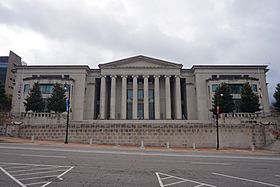Alabama Judicial Building facts for kids
Quick facts for kids Heflin-Torbert Judicial Building |
|
|---|---|

The Heflin-Torbert Judicial Building
|
|
| General information | |
| Location | 300 Dexter Avenue Montgomery, Alabama, United States |
| Coordinates | 32°22′37″N 86°18′16″W / 32.37694°N 86.30444°W |
| Completed | 1994 |
| Cost | $35 million |
| Owner | State of Alabama |
| Height | |
| Roof | 158 feet (48 m) |
| Technical details | |
| Floor count | 4 above ground, 2 below |
| Floor area | 338,000 square feet (31,401 m2) |
The Heflin-Torbert Judicial Building, often called the Alabama Judicial Building, is a very important government building in Montgomery, Alabama. It's where some of Alabama's most important courts are located. These include the Supreme Court of Alabama, the Alabama Court of Civil Appeals, and the Alabama Court of Criminal Appeals. This building was the first in the United States to have all three of these state courts together under one roof! It also holds the State Law Library, which is a huge collection of legal books.
This building was finished in 1994 and cost about $35 million to build. It was designed in a style called neoclassical, which means it looks like ancient Greek and Roman buildings.
Contents
Building Design and Features
The Judicial Building is a modern take on neoclassical architecture. It was designed by two groups of architects: Barganier Davis Sims Architects Associated from Montgomery and Gresham, Smith and Partners from Birmingham. The building sits on a city block that is about 300 by 320 feet (91 m × 98 m).
Outside the Building
The building stands about 158 feet (48 m) tall at the top of its large dome, which is 100-foot (30 m) wide. The outside of the building is covered in Indiana limestone. At the front, there's a grand entrance with ten huge Ionic columns. This part is called a portico and it has a triangular roof section above it, known as a pediment.
Inside the Building
The inside of the building is built around a central area called a rotunda. This rotunda is about 40 feet (12 m) tall and 75 feet (23 m) wide. It's decorated with beautiful Carrara marble and has eight marble columns that are 34 feet (10 m) tall.
The building has 338,000 square feet (31,401 m2) of space spread out over six levels.
- The basement level has a parking garage and the building's mechanical systems.
- On the ground floor, you'll find the Administrative Office of Courts, a Museum of Judicial History, and visitor parking.
- The main lobby level is where the main entrance is. It also has the State Law Library and the offices for the Appellate Court Clerks. The two-story rotunda is also on this level.
- The second level is home to the Court of Civil Appeals and the Court of Criminal Appeals, along with their courtrooms.
- There's also a mezzanine level with rooms for storing old records, holding meetings, and general storage.
- The Supreme Court chamber, where the highest court meets, is on the third and top level. It's located right above the rotunda and directly under the dome.
The Ten Commandments Monument
In 2001, Roy Moore was the Chief Justice of the Supreme Court of Alabama. On August 1, 2001, it was revealed that he had placed a 5,280-pound (2,390 kg) granite copy of the Ten Commandments in the building's rotunda. He did this without telling the other eight justices of the Supreme Court.
Legal Challenge and Removal
This placement of a religious monument in a government building caused a lot of discussion across the country. Three lawyers filed a lawsuit called Glassroth v. Moore. They argued that the monument went against the Establishment Clause of the First Amendment. This part of the Constitution says that the government cannot establish or favor any religion.
The court decided that the monument had to be removed. Chief Justice Moore did not want to remove it. Many people came to the Judicial Building to protest against the monument's removal. However, the other eight justices of the Alabama Supreme Court ordered the building manager to follow the court's decision. The monument was moved from the rotunda into storage on August 27, 2003. It was finally taken out of the building on July 19, 2004.
Aftermath
After the monument was removed from public view, a complaint was filed against Chief Justice Moore. He was removed from his position on November 13, 2003. However, in 2012, the people of Alabama voted for him to return as Chief Justice, and he began his second term in January 2013.
See also

